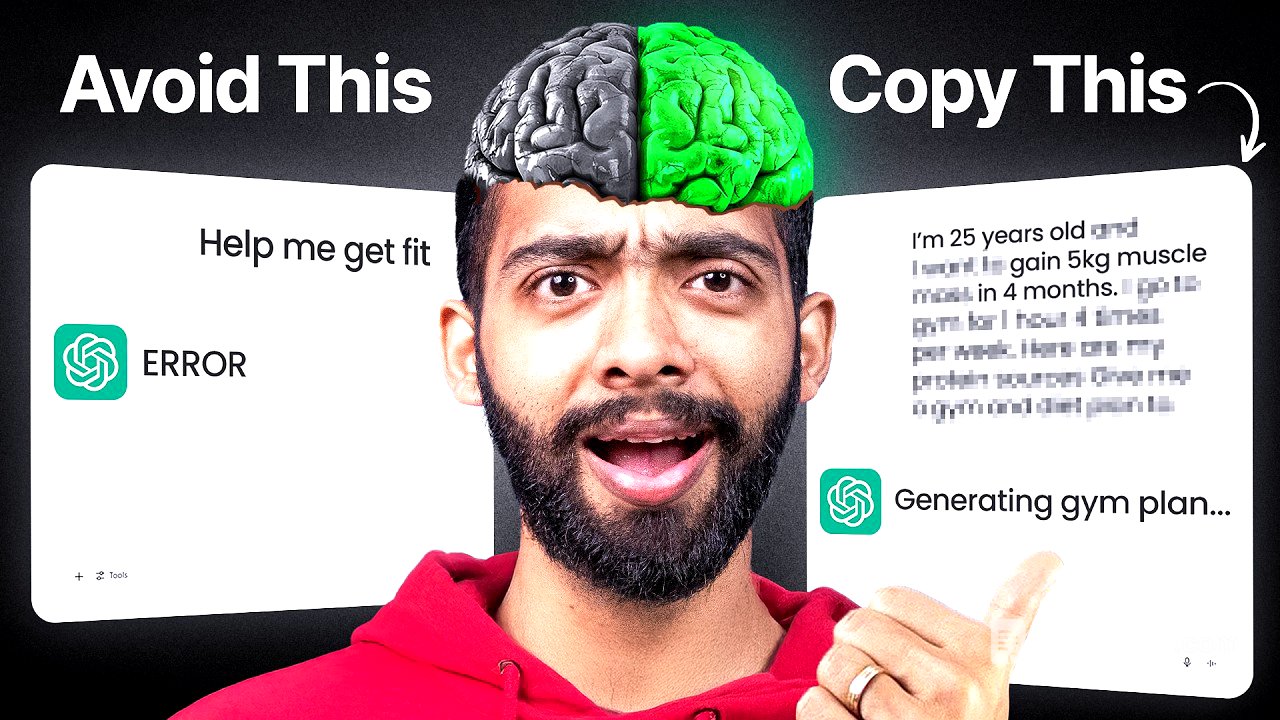TLDR;
This video provides a comprehensive guide on effectively using AI tools like ChatGPT for students and professionals. It emphasizes the importance of detailed and specific prompting to get personalized and useful outputs. The video also covers practical tips and tricks for refining prompts, leveraging AI for various tasks beyond basic email writing, and being aware of the limitations and potential biases of AI.
- Importance of detailed and specific prompts for effective AI use.
- Practical tips for refining prompts and getting personalized outputs.
- Awareness of AI limitations, including elusiveness, cut-off dates, and potential biases.
Introduction: The Importance of Using AI [0:00]
The video starts by highlighting the necessity of using AI in daily life for both students and professionals to avoid being left behind. The speaker emphasizes that understanding how to use AI is crucial in today's world and introduces the topic of the biggest mistake people make when using AI: lazy prepping.
The Biggest Mistake: Lazy Prepping [0:27]
The most common mistake when using AI is lazy prepping, which involves providing generic and insufficient context in prompts. For example, simply asking for a "gym plan" yields a generalized response. To improve results, it's essential to provide detailed context, such as age, fitness goals, gym frequency, and available protein sources. This allows AI to generate personalized and effective plans.
Four Hacks for Effective Prepping [2:19]
The video introduces four hacks to improve AI prepping:
- End prompts with "Ask me further questions to get me a personalized detailed output" to encourage AI to seek additional context.
- Communicate with AI as you would with a friend, providing all necessary details upfront.
- Use voice mode to dictate prompts, overcoming laziness in typing detailed requests.
- Utilize Chat GPT as a prompt generator by instructing it to follow a four-step process to refine your prompts.
Three Experience-Based Tips [4:47]
Three experience-based tips are shared to enhance AI usage:
- Accept that initial attempts may not yield perfect results and revise prompts based on the AI's response.
- Specify the desired tone of the output (e.g., professional, casual) to align with your needs.
- Request outputs in the form of tables or steps for easier understanding and reduced effort.
Expanding AI Use Cases Beyond the Basics [5:51]
The video encourages users to explore AI beyond basic tasks like email writing and note summarization. It suggests using AI to solve specific problems, such as creating a protein intake plan within a limited budget or generating creative birthday gift ideas. The key is to input detailed problems and constraints to receive tailored solutions.
Leveraging AI Instead of Google [6:42]
Instead of using Google for initial research, the video suggests directly asking AI tools. This approach saves time and provides direct, personalized responses. For example, when planning a trip, ask AI for places to visit instead of searching on Google.
Exploring Other AI Tools [7:02]
The video introduces several AI tools beyond Chat GPT, each suited for different use cases:
- Perplexity: For the latest news and sources.
- Analyze Cloud: For working with large files or PDFs.
- Notion AI: For note-taking and writing support.
- Gemini: For real-time question answering via live streaming.
- Hazen: For advanced AI applications.
The speaker recommends using Perplexity on iPhones due to its superior voice assistant capabilities.
Awareness of AI Limitations [8:11]
The video discusses the limitations of AI:
- Elusiveness: AI may provide confusing answers instead of admitting it doesn't know. Fact-checking is essential. Use prompts like "provide sources" or "say I don't know if unsure" to mitigate this.
- Cut-off Dates: Chatbots have data cut-off dates (e.g., June 2024 for Chat GPT and Gemini). For events after this date, AI needs internet access.
- Bias: AI can exhibit biases based on its training data. To counter this, use prompts like "give me a neutral opinion without any biases" and "add all the pros and cons of the situation."
Conclusion [9:28]
The video concludes by referencing a similar video from two years ago, noting that its tips are still relevant. It encourages viewers to continue exploring and learning about AI to maximize its benefits.









